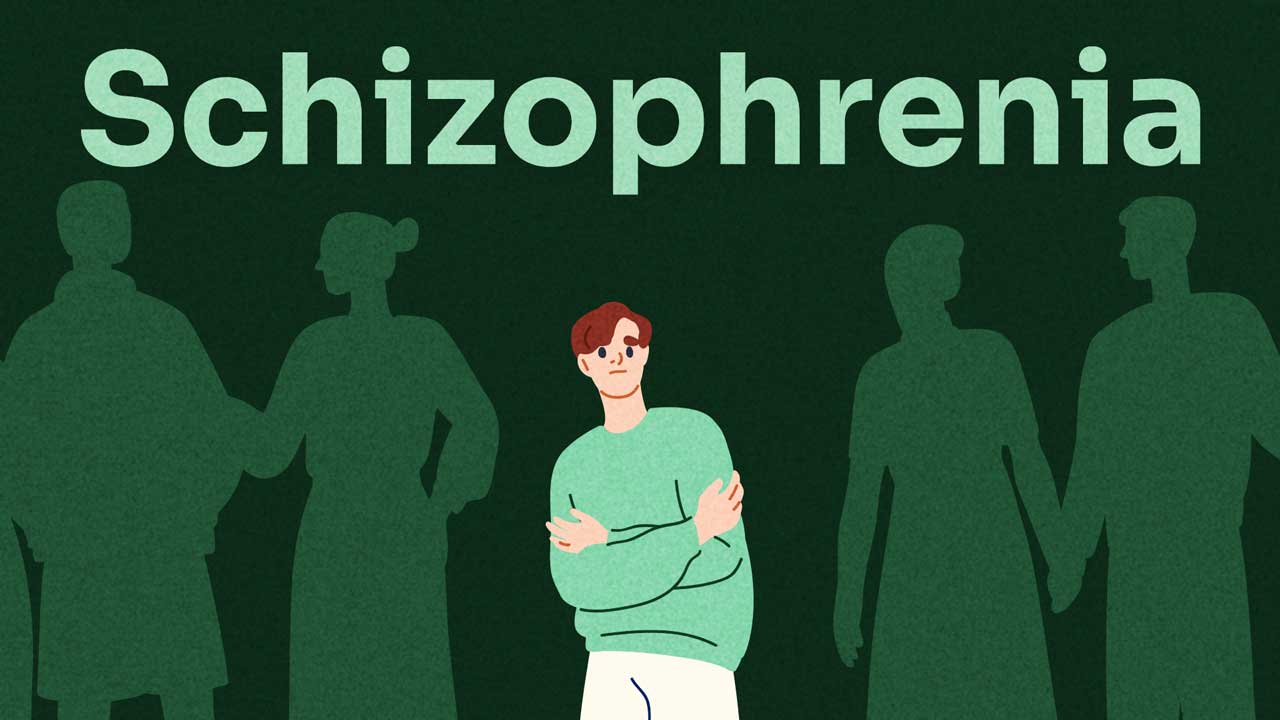Schizophrenia is a severe and chronic mental illness. It is marked by disturbances in thought, perception and behaviour (Hurley 2022).
Schizophrenia is characterised by psychosis resulting in distortion in thinking, emotions, language, sense of self and behaviour (WHO 2022).
People who have schizophrenia will commonly experience hallucinations (hearing voices or having visions that are imagined) and delusions (fixed and false beliefs) (WHO 2022).
They may have difficulty functioning in settings such as work or school and in social relationships (Healthdirect 2023).
Schizophrenia is a widely misunderstood and stigmatised illness that is often associated with erratic or violent behaviour. Despite this, people who have schizophrenia are no more likely to be violent than anyone else, and in fact, are more likely to be survivors of violence than perpetrators (Better Health Channel 2019; SANE 2022).
People with schizophrenia are vulnerable to human rights violations both in mental health institutions and in communities. This discrimination can impact access to healthcare, education, housing and employment (WHO 2022).

Schizophrenia Statistics
Schizophrenia affects approximately 1 in 300 or 24 million people worldwide (WHO 2022).
Schizophrenia usually begins during a person’s late teens or early 20s, but it can also develop later in life (SANE 2022).
The disorder is slightly more common in men than in women, and men tend to show symptoms earlier than women (SANE 2022; WHO 2022).
Causes of Schizophrenia
Research has not identified a singular cause of schizophrenia - it is thought to be a combination of genetics and a range of environmental factors such as trauma, stress, problems at birth and significant drug use (WHO 2022; ReachOut 2023).
DSM-5 Diagnostic Criteria for Schizophrenia
- Two or more of the following symptoms must be present for at least one month or longer. At least one of these symptoms must be delusions, hallucinations or disorganised speech:
- Delusions
- Hallucinations
- Disorganised speech
- Grossly disorganised or catatonic behaviour
- Negative symptoms, such as diminished emotional expression.
- Signs of the disorder must last a continuous period of at least six months. This six-month period must include at least one month of symptoms (or less if treated) that meet criterion A (active phase symptoms) and may include periods of residual symptoms. During residual periods, only negative symptoms will be present.
- There must be impairment in one of the following primary areas of functioning for a significant period of time since the onset of the disturbance: work, interpersonal relations or self-care.
- Schizoaffective disorder and bipolar or depressive disorder with psychotic features have been ruled out.
- The disturbance isn’t caused by the effects of a substance or another medical condition.
- If there is a history of autism spectrum disorder or a communication disorder, the diagnosis of schizophrenia is only made if prominent delusions or hallucinations (along with other symptoms) are present for at least one month.
(APA, as cited by Hurley 2022)

The impact a schizophrenia diagnosis will have on someone’s life is not possible to measure because the symptoms, severity and pattern of illness over time differ vastly between people (SANE 2022).
Symptoms of Schizophrenia (as Recognised by the DSM-5)
- Inappropriate affect (for example, laughing in the absence of a stimulus)
- Disturbed sleep pattern
- Dysphoric mood
- Anxiety and phobias
- Depersonalisation (feeling a disconnect from the self)
- Derealisation (feeling as if the external world is not real)
- Cognitive deficits impacting language, processing, executive function and/or memory
- Lack of insight into the disorder
- Social cognition deficits
- Hostility and aggression.
(APA, as cited by Hurley 2022)
Treatments for Schizophrenia

Pharmacological
The most common pharmacological treatment for schizophrenia is antipsychotic medications. These influence the way the brain responds to chemicals such as dopamine. They can be useful for dulling frightening experiences such as unwanted visions or sounds. However, these medicines may have side effects (Reach Out 2023).
Psychological Therapies
Psychotherapy for schizophrenia can help to implement coping strategies for dealing with stress and improving quality of life. Therapy has been shown to be particularly effective in people who hear voices. Therapies include cognitive behavioural therapy (CBT), acceptance therapy and commitment therapy (Reach Out 2023).
Lifestyle Changes
Improving general health and reducing stress may make it easier to manage the symptoms of schizophrenia. Activities to reduce stress may include art, music, exercise and support recovery. Getting adequate sleep and avoiding drugs and alcohol is advised (Reach Out 2023).
Support
Assistance in terms of study and work may be useful in reducing stress for people with schizophrenia (Reach Out 2023).
Many people who have schizophrenia are still able to live full, productive lives, and it’s possible to recover completely from schizophrenia. Some people will only ever have one episode of psychosis and then recover well (Healthdirect 2023).
If you’re in crisis and need support, call Lifeline on 13 11 14. Lifeline is open 24 hours a day, 7 days a week.
Test Your Knowledge
Question 1 of 3
True or false: People who have schizophrenia are more likely to be survivors of violence than perpetrators.
Topics
Further your knowledge
References
- Better Health Channel 2019, Home Mental Health and Wellbeing, Victoria State Government, viewed 4 February 2025, https://www.betterhealth.vic.gov.au/health/conditionsandtreatments/mental-illness-and-violence
- Healthdirect 2023, Schizophrenia, Australian Government, viewed 4 February 2025, https://www.healthdirect.gov.au/schizophrenia
- Hurley, K 2022, Schizophrenia: DSM-5 Definition, Psycom Pro, viewed 4 February 2025, https://pro.psycom.net/assessment-diagnosis-adherence/schizophrenia
- ReachOut 2023, What is Schizophrenia?, ReachOut, viewed 4 February 2025, https://au.reachout.com/articles/what-is-schizophrenia
- SANE, Schizophrenia, SANE, viewed 4 February 2025, https://www.sane.org/information-and-resources/facts-and-guides/schizophrenia
- World Health Organisation 2022, Schizophrenia, WHO, viewed 4 February 2025, https://www.who.int/news-room/fact-sheets/detail/schizophrenia
 New
New 

